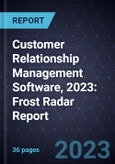Businesses want collaborative customer relationship management (CRM) software that unifies all resources related to a particular deal and customer, eliminating siloes between different customer-facing teams and departments. Most CRM vendors already offer solutions with collaboration features that can integrate with contact center applications, but they need to continue ironing out the creases that hinder optimal integrations to outperform their competitors.
With tremendous volumes of customer interaction data available, both unstructured and structured, organizations struggle to integrate and streamline it for use from a single place. To help, they will invest in AI-enabled CRM software that can analyze customer records and business data collected across channels. Frost & Sullivan finds that “becoming more data-centric” is one of the top business priorities among enterprise decision-makers. As a result, reliance on AI and data analytics will increase. More customer actions will be captured by artificial intelligence (AI)-driven CRM systems to maximize value. Social media conversations and Internet of Things-connected products will be deeply mined for insights, including for improvements and anticipatory, intent-based, targeted offers.
In the next year, dealing with security and privacy concerns will be among the top challenges IT departments face. Any kind of data mix-up or theft can lead to heavy losses and serious repercussions. CRM vendors will need to offer an advanced level of security for data protection.
CRM tools will continue to integrate data from a variety of sources, including the Internet of Things (IoT). IoT devices can provide data about product issues, maintenance needs, and improper use. With the expansion in data sources, businesses will be able to monitor their end customers and offer services in new and proactive ways.
Competition will intensify in the CRM market with new use cases and industry-specific solutions coming up. Also, smaller vendors will continue to enter and challenge large vendors that offer a suite of solutions, including CRM.
The Frost Radar reveals the market positioning of companies in an industry using their Growth and Innovation scores as highlighted in the Frost Radar methodology. The document presents competitive profiles of each of the companies in the Frost Radar based on their strengths, opportunities, and a small discussion on their positioning. Frost & Sullivan analyses hundreds of companies in the industry and benchmarks them across 10 criteria on the Frost Radar, where the leading companies in the industry are then positioned. Industry leaders on both the Growth and Innovation indices are recognized as best practice recipients.
Table of Contents
1. Strategic Imperative and Growth Environment
- The Strategic Imperative
- The Growth Environment
2. Frost Radar™
- Frost Radar™: Global CRM Software Market
- Frost Radar™: Competitive Environment
3. Companies to Action
- Adobe
- Freshworks
- HubSpot
- Microsoft
- monday.com
- Oracle
- Pegasystems
- Salesforce
- SAP
- SugarCRM
- Zendesk
- Zoho
4. Strategic Insights
5. Next Steps: Leveraging the Frost Radar™ to Empower Key Stakeholders
- Significance of Being on the Frost Radar™
- Frost Radar™ Empowers the CEO’s Growth Team
- Frost Radar™ Empowers Investors
- Frost Radar™ Empowers Customers
- Frost Radar™ Empowers the Board of Directors
6. Frost Radar™ Analytics
- Frost Radar™: Benchmarking Future Growth Potential
- Legal Disclaimer
Companies Mentioned (Partial List)
A selection of companies mentioned in this report includes, but is not limited to:
- Adobe
- Freshworks
- HubSpot
- Microsoft
- monday.com
- Oracle
- Pegasystems
- Salesforce
- SAP
- SugarCRM
- Zendesk
- Zoho








